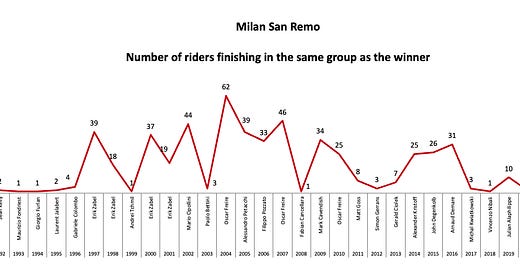It’s never a bunch sprint. We wonder from year to year if it will be won by a daring escape up the Poggio like Mathieu van der Poel or Vincenzo Nibali, or maybe an even more daring escape down the Poggio like Sean Kelly or Matej Mohoric. Or, we wonder, will it all come back together for a bunch sprint on the Via Roma.
It’s never a bunch sprint. Milan-Sanremo never ends in a bunch sprint.
Of course, this all depends on what our definition of ‘bunch’ is. The answer is not straight-forward. ‘Bunch’ is usually in the eye of the bebuncher.
Any group that is less then 10 riders, I think we can all agree is just that - a group. It’s a minority subsection of the bunch which has broken clear and are contesting the win among themselves without the bunch.
What about 20 riders? 30 riders? 40? Is that a bunch? These are big enough groups to display certain bunch dynamics. Several riders could potentially have enough teammates for there to be several lead-out trains competing in a group that size. It might display some of the characteristics of a bunch, but it is almost certainly not the bunch.
By my definition, the bunch is the biggest group in the race. If the biggest group in the race is off the front and you’re off the back, well then you are off the back of the bunch. If the opposite is the case, well then you are attacking the bunch. If the biggest group is in the middle somewhere, then there are groups ahead of the bunch and have been dropped by the bunch.
(I’ve written bunch so many times it reminds me of this magnificent clip of John Giles and Eamon Dunphy saying the word ‘player’ to an absurd degree)
Even in the years that you might think you remember Milan-Sanremo ending in a bunch sprint, you’re wrong.
This is the past 25 years of Milan-Sanremo. On this plot are the sizes of the group which the winner was in when they crossed the line.
Keep reading with a 7-day free trial
Subscribe to The Backpedal to keep reading this post and get 7 days of free access to the full post archives.



